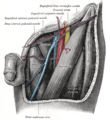- Sartorius muscle
-
Sartorius muscle Muscles of lower extremity. (Rectus femoris removed to reveal the vastus intermedius.) Latin musculus sartorius Gray's subject #128 470 Origin inferior to the anterior superior iliac spine Insertion anteromedial surface of the upper tibia in the pes anserinus Artery femoral artery Nerve femoral nerve (sometimes from the intermediate cutaneous nerve of thigh) Actions Flexion, abduction, and lateral rotation of the hip, flexion of the knee[1] The Sartorius muscle – the longest muscle in the human body – is a long thin muscle that runs down the length of the thigh. Its upper portion forms the lateral border of the femoral triangle.
Contents
Origin and insertion
The sartorius muscle arises by tendinous fibres from the anterior superior iliac spine, running obliquely across the upper and anterior part of the thigh in an inferomedial direction.
It descends as far as the medial side of the knee, passing behind the medial condyle of the femur to end in a tendon.
This tendon curves anteriorly to join the tendons of the gracilis and semitendinous muscles which together form the pes anserinus, finally inserting into the proximal part of the tibia on the medial surface of its body.
Etymology
Sartorius comes from the Latin word sartor, meaning tailor,[2] and it is sometimes called the tailor's muscle.
There are four hypotheses as to the genesis of the name: One is that this name was chosen in reference to the cross-legged position in which tailors once sat. Another is that it refers to the location of the inferior portion of the muscle being the "inseam" or area of the inner thigh tailors commonly measure when fitting a pant. A third is that the muscle closely resembles a tailor's ribbon. Additionally, antique sewing machines required continuous cross body pedalling. This combination of lateral rotation and flexion of the hip and flexion of the knee gave tailors particularly enlarged sartorius muscles.
Actions
Assists in flexion, abduction and lateral rotation of hip, and flexion of knee.[1] Looking at the bottom of one's foot, as if checking to see if one had stepped in gum, demonstrates all four actions of sartorius.
Innervation
Situated in the anterior fascial compartment of the thigh, the sartorius is innervated via the anterior (or superficial) branch of the femoral nerve (AORN Journal, J. Murauski). The femoral nerve is responsible for both sensory and motor components in the sartorius and provides proprioceptive feedback for the muscle (Anatomy and Physiology 5th edition, K. Saladin)
Pathology
One of the many conditions that can disrupt the use of the sartorius is pes anserine bursitis, an inflammatory condition of the medial portion of the knee. This condition usually occurs in athletes from overuse and is characterized by pain, swelling and tenderness. The pes anserinus is made up from the tendons of the gracilis, semitendinosus, and sartorius muscles; these tendons attach on to the anteromedial proximal tibia. When inflammation of the bursa underlying the tendons occurs they separate from the head of the tibia (eMedicine, MD. M. Glencross).
Variations
Slips of origin from the outer end of the inguinal ligament, the notch of the ilium, the ilio-pectineal line or the pubis occur.
The muscle may be split into two parts, and one part may be inserted into the fascia lata, the femur, the ligament of the patella or the tendon of the Semitendinosus.
The tendon of insertion may end in the fascia lata, the capsule of the knee-joint, or the fascia of the leg.
The muscle may be absent (Scott-Conner, Carol E. H.; David L. Dawson (2003). Operative Anatomy. Lippincott Williams & Wilkins. ISBN 0781735297. http://books.google.com/books?id=06GvkEYPg20C. p.606).
Additional images
References
External links
- 208339022 at GPnotebook
- LUC sart
- SUNY Labs 14:st-0407
- Cross section at UV pembody/body15a
- Cross section at UV pelvis/pelvis-e12-15
This article was originally based on an entry from a public domain edition of Gray's Anatomy. As such, some of the information contained within it may be outdated.
List of muscles of lower limbs (TA A04.7, GA 4.465) ILIAC Region
/ ILIOPSOASBUTTOCKS THIGH /
compartmentssartorius · quadriceps (rectus femoris, vastus lateralis, vastus intermedius, vastus medialis) · articularis genuLEG/
Crus/
compartmentssuperficial · triceps surae (gastrocnemius, soleus, accessory soleus, Achilles tendon) · plantaris
deep · tarsal tunnel (flexor hallucis longus, flexor digitorum longus, tibialis posterior) · popliteusfibularis muscles (longus, brevis)FOOT DorsalPlantar1st layer (abductor hallucis, flexor digitorum brevis, abductor digiti minimi) · 2nd layer (quadratus plantae, lumbrical muscle) · 3rd layer (flexor hallucis brevis, adductor hallucis, flexor digiti minimi brevis) · 4th layer (dorsal interossei, plantar interossei)Categories:- Hip abductors
- Hip flexors
- Hip lateral rotators
- Knee flexors
- Thigh muscles
Wikimedia Foundation. 2010.







